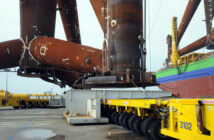Hydraulic presses consume a considerable amount of energy – this is now no longer necessary: Schuler AG in Göppingen, Germany, the leading manufacturer in metal forming focuses on a new technology that helps hydraulic presses to become more efficient. Energy savings of up 60% are possible. This new technology is called Efficient Hydraulic Forming and can be retrofitted for installed presses.
Hydraulic presses in production
Electric motors and high-performance pumps generate pressures in hydraulic presses of up to 300 bar resulting in pressure forces of up to several thousand tonnes. They are used throughout in the entire metal forming sector and are primarily suitable for drawing operations. The reason for this is that the entire stroke length is available for maximum force, while the position of the plunger is irrelevant.
Hydraulic presses can be very easily adjusted with respect to the force and speed used. In addition, the drives can be installed in any area. They are protected against overload and enable these machines to generate very high forces.
Hydraulic presses are also used for cutting. They offer the advantages of being flexibly implemented and easily retrofitted. This is where they differ significantly from mechanical presses. Metal forming machine manufacturer Schuler has now taken full advantage of easy retrofitting for its Efficient Hydraulic Forming. This has resulted in a system that can be used to save energy, which can be nothing other than beneficial in light of the necessity for constant cost-cutting measures in manufacturing companies. It is not without reason that Switzerland’s largest forging press is now in operation with the new technology from Schuler.
New technology for greater efficiency
Compared to conventional systems, the hydraulic presses are said to consume about 60% less energy thanks to Efficient Hydraulic Forming. The new technology from the metal forming equipment company Schuler focuses on optimisation and energy savings throughout all areas hydraulic system operation. Machine operators are not tasked to save on energy – the savings are brought about automatically. The great advantage is that this technology can be retrofitted to systems that are already in operation.
The Efficient Hydraulic Forming technology offers a stand-by function, which can be used to switch off main drives when they are not in use. This in turn means that no energy is consumed when it is not actually required for the forming process. The start-up system for this feature has already been patented.
This new technology avoids the normal start-up characteristics available for existing drives. Shortest interruptions in the production and forming processes are already utilised in order to save energy. Although these short interruptions may seem insignificant at first glance, they can add up to a surprisingly long period of time in which power is consumed though not required.
Efficient Hydraulic Forming offers yet another advantage that should not to be neglected particularly in light of the noise level generated by the forming process in many production companies: the reduction in noise levels when the equipment is switched off when not in use. This is much more pleasant for all employees involved in the production process and is evaluated accordingly by users as positive.
Power take-offs and secondary functions
Although the secondary functions of a metal forming system are supplied acyclicly, this depends on the state of the particular system. The speed control of PTOs can be operated differently thanks to the new forming technology. Normally, all units of a metal forming system run constantly at a high rate of speed. This speed is not decreased or adapted as required thereby resulting in frequent idle periods and unnecessary consumption of energy.
Thanks to Efficient Hydraulic Forming, however, speed-controlled operation of the drive is now possible. The secondary functions are always supplied power when they are actually being used. This thus prevents losses that may occur from constant no-load operation. Here again, the savings potential is tremendous.
Other advantages of the new technology
With its Efficient Hydraulic Forming technology, metal forming machine manufacturer Schuler offers a technology optimised for efficiency. The modular hydraulic system can be integrated into existing systems thereby enabling the feedback of energy. Good to know: this technology requires only a low cooling capacity. The control valves in the main circuit have been eliminated and have been replaced by servo pumps that handle the control valve functions. Schuler has done considerably more to optimise the systems such as greatly reducing the number of components located in the main circuits. Only those components that are absolutely necessary still remain. This shows again that it is possible to get along with a minimum number of components and that the system can be operated with much greater energy efficiency. The safety regulations were of course adhered to so that reducing the number of components does not result in a violation of safety requirements.
The system is able to store the energy saved. But this energy is not simply saved and not used, it is fed to and recycled back to the further production process. The potential energy the plunger has in the rapid downstroke can be utilised. The energy generated by the oil compression is also recycled when released. In this case, the oil run-off drives units, which in turn generate power for electric motors.
One practical example: Imbach & Cie. in Nebikon, Switzerland
The new Efficient Hydraulic Forming technology is already being successfully implemented in practice. Imbach & Cie. in Nebikon is using this technology in the largest forging press Switzerland has to offer. With a pressing force of about 3,000 tonnes, the system from Schuler is used to form workpieces into various components such as ring blanks, shafts and discs as well as a variety of other components. The workpieces produced can weigh up to four tonnes and have a maximum size of 2.5 metres (height) or 1.4 metres (diameter). The system is able to operate at up to forty strokes … per minute.
Equipped with Efficient Hydraulic Forming, it was possible to optimise the system and thereby increase pressing force and production rates many times over. The power consumption, however, has remained almost the same. This means that the system can be operated much more efficiently. In terms of optimisation measures of a high quality production company, the plans have been realised and at the same time the competitiveness has been increased.
Photo credits: © Schuler AG










